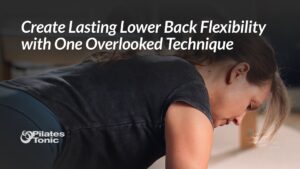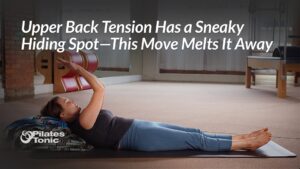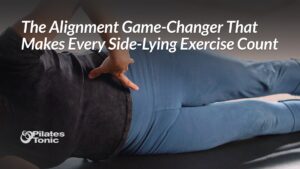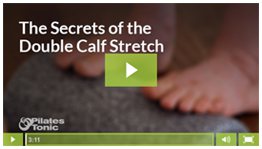The bridge is one of my all-time favorite exercises! It's my go-to solution when my back is feeling tight and when I want to really activate my glutes.
But it hasn't always been a pleasant experience for me. My glutes used to be inactive and my hamstrings would cramp like crazy every time I did a bridge.
Today’s video will teach you how to keep hamstring cramps at bay and show you how to get a lot more than you might imagine from such a simple exercise.
Have you ever had hamstring cramps when doing the bridge?
How does this version feel when you compare it to the way you normally do the bridge?
Let me know in the comments below, or just click the Contact link at the top of this page and send a note.
Thanks so much for checking in and see you in the studio!
Sydney
P.S. Our free mini workshop on the foot is getting rave reviews and it's still available. You can read more about it and register for free access here: Foot-Talk: A Powerful Foot Alignment Training





32 Responses
Hi,
I just wanted to say a BIG thanks for this video. I’m doing bodyweight strength training and as part of that I’ve been practising holding wrestler bridges. It was going fine until about a month ago, when I started getting severely, er, hamstrung. I was at about 40-50 seconds holding time and one or the other hamstring would start cramping and I’d have to bail. Once I tried to hold through the cramp – will not do that again!
I did some research and quickly realized the problem is either weak or improperly activated glutes. I didn’t think it could be weakness since they were managing fine before, so I started looking at advice for glute activation exercises and whatnot. I was trying the glute-bridge and feeling a fool for not being able to activate glutes without hamstring eventually creeping in – getting nowhere really.
Then I found this video. Praise be. I tried wrestler bridge holding again following your advice yesterday and managed two sets of one minute each (new PR). First set was easy, second set I could feel it was my neck tiring – no hint of hamstring cramps!
Delighted such a simple solution works so effectively.
I’m going to look through other articles now, I’m sure there’s more useful stuff.
Thanks again, I really appreciate this.
Hi Greg, that is fantastic! I’m thrilled you found the video helpful. Thank you!
Nice video, Sydney! I would be interested in knowing more about activation vs squeezing -how the latter Doesn’t activate the glutes. I’ll need to try this a few times. I’m not really getting how to feel pressure under my toes(?), and even what hip width apart is. Does that mean the outside of her hip bone is in line with our knees?
Hi Belle, Check out this article to learn more about squeezing the glutes vs activating them. With regards to feeling the points of your feet on the ground, do you find one point more difficult to feel than the others? If so, you might try placing a small folded washcloth under the point that’s difficult to feel. This will help bring the floor to your foot and make the connection easier to find. As for the width of the feet, make your feet about sitting bones distance apart. Hope this helps!
I just tried it your way, and for some reason, felt it more in my lower back. Any ideas why? I’m finding it a bit hard to push my feet into the ground as well.
Hi Belle, Check out the suggestions above and let me know how it goes. Thank you for your questions!
Thank you so much. I’ve just re-watched the video for maybe the fourth time. My first attempts were done with my toes (not the toe knuckles) planted into the ground. Needless to say, I got a Charley horse foot cramp!!
I tried it again and I’m feeling more glute(s)!! Unfortunately my right glute does not really activate. Only my left does (which is a bit frustrating), so I’ll repeat this again and again with one leg. I’ll update you if I notice more changes!
Slightly off topic, but I’ve also done Single Leg Foot Elevated Glute Bridges. I’m still feeling my hamstrings a Lot when I do my right leg. & In the bridge position, when I move my feet closer to my bum, sometimes I feel it in my knees. So another thing I’d love to know, is how do you get your knee to feet position just right? Thank you for your help so far.
Hi Belle,That’s great news that you could feel the glutes more when you connected your toe knuckles to the ground. It’s hard for me to say for sure what’s going on with your right side without seeing you, but it’s possible you may need some glute activation exercises. You could also try stretching your hip flexors first. Effectively stretching your hip flexors may also help with what you’re feeling in your knees when you bring the feet in closer to your body. Try this exercise before your bridge next time and let me know how it goes. Thanks for your questions!
Thanks for that. I managed to do the hip flexor stretch a few times. Unfortunately, when I do the single leg glute bridge, I still get the hamstring cramp on my right side. My left glute fires almost perfectly, but the right glute doesn’t. It is so frustrating.
Hi Belle, Sound like your right side could use some glute activation exercises. At the bottom of this post is an exercise you might try. Thanks for your feedback!
nicely described and easy yo follow. goodbye cramping hammies
thanks 🙂
Thank you Mark! Glad you enjoyed the video.
Hi Sydney, this is an awesome explanation and demonstration of the bridge technique! Got my hamstrings to stop cramping after recently moving onto single leg bridges. Thanks so much for sharing it!
I really appreciate your feedback Kevin. I’m thrilled you found the video helpful!
hey,,thanx for the instruction but i still dont feel it in my glutes just my thighs.. where am i going wrong ?
Hi Mishie, have you tried stretching your hip flexors? Here’s an exercise to try before your bridge. Thanks for your feedback!
Thanks Sydney. I have been struggling to get my glutes kicking for a couple years now. I felt some progress after following your instructions. Just like I was checking back in with my feet, I would love to check back in with you in a month or so.
I’d love to hear how everything goes Tim. Thanks for your feedback!
When my feet are as far away from the body, as in this video, it definitely triggers my hamstrings. I get it less if I have my knees closer to my butt so my knee to foot is a straight line when up in the bridge. Will try this way though but it seem like having the feet further away (especially in someone with long femur, like this guy), there’s less lever.
Hi Elle, Actually, having a vertical shin (knee to foot in a straight line) for bridging is ideal. Thanks for sharing your feedback!
Hi Sydney. I am always looking for new insight into the bridge. I find so many of my clients ram their weigh into their feet and thrust up in one long plank almost enevitably cramping and spasming in the hamstrings. I prefer to start placement as you do, with the feet, then continue to make contact points with the tailbone, shoulder blades through base of skull, having the spine and pelvis long and neutral. At that point, I have them activate the TVA though naval to spine, which I believe places the pelvis in a ppt from neutral first. From here, I have them peel the spine, vertebrae by vertebrae, slowing supporting through the glutes and hamstrings as needed, till shoulder bridge is fully executed. Would love your opinion? Thank You!
Hi Spay! I love the attention to length you start with by bringing awareness from the feet through the base of the skull! I’ve found clients often suck in the stomach and clench there bottoms in response to “navel to spine”. Here’s a blog post that goes into more detail on the subject.
Articulating up into a bridge without tucking and squeezing the glutes can be challenging to cue! Lately, I’ve been cueing to hover the pelvis just barely off of the mat and then having folks pause to release any tail tucking or bottom clenching. From there, I’ll ask them feel their feet again and then imagine their pelvis riding on the femur heads, as though their pelvis is riding on an escalator away from the ribs. Another image I find effective, is imagining the spine like the coils of a spring. As they lift into a bridge, they want to open the full circumference of their spine-spring coils without crunching the front or back of the springs. This blog post demonstrates a side-bend using this concept.
Thanks so much for your comment! 🙂
Hi. I’m not sure how I see the video relating to this post. Do I need to have an account?
Hi Matthew, There was an issue with embed code for this video that has been fixed. The video should play now. Thanks for bringing this to our attention!
Oh, my God! THANK YOU! Post total hip repair and very inactive, and it’s all been sliding into hell, but this has enabled a bridge, which is going to help with standing and walking, that will almost certainly help with breathing for this nurse who can’t afford health insurance. You may have prolonged my life by a decade or more.
Wow Barbara, thanks so much for sharing! That’s wonderful to hear!
Femur as a spatial, let the bones do the work, wow, witch craft, life may never going be the same again.
Ha ha, hope it was helpful!
Sydney
So I watched your video, I get cramps in my hamstring (I did not use to, but now I do) and your explanation, I am sorry I am not following? I am a medical provider and the comments of, “make sure pressure felt behind great toe knuckle, and pinky toe and heel”-what? And then how am I suppose to lift my butt up w/o the hamstring firing, not following at all??
Hi Twana, great questions. It’s not that you don’t want to use your hamstrings, they definitely have to work for this exercise. The form points help distribute the work more evenly through the hamstrings, back of the legs, and deep glutes. Grounding through the feet is helpful because often people will roll to the outside edges of their feet, or collapse through the ankles sending them into compensatory habits and setting their hamstrings up to work harder than necessary. Thanks for your question!
Thank you for your great videos. I have learned how to do a proper start of the bridge from you (breath in and let the tailbone flow back, and then breath out and forward). And my form has improved so much.
I think I don’t have proper form when I’m rolling through my upper (tense) back. Especially when I’m rolling down. I have a hard time distinguishing the individual vertebrae because I am so tense. I keep practising but I wonder if there is any kind of clue I’m missing. How is it supposed to look? And more importantly feel.
I have done this exercise multiple times at week for the last 6 months so it’s not for lack of trying.
Hi Marie,
Thanks for your feedback and questions! Rolling through the upper back in a bridge can be tricky because often the upper back and ribcage area can be a bit stuck. It might be helpful to practice exercises to help release the tension in your upper back and then come back to the bridge.
Here are a couple exercises you could try that might help:
Thoracic Stretch on Floor
https://www.pilatestonic.com/2022/sitting-all-day-fix-the-slouch-and-back-pain-with-this-easy-exercise/
Thoracic Stretch on Wall
https://www.pilatestonic.com/2020/got-computer-slouch-theres-a-simple-fix-that-feels-fantastic/
Floor Stretch
https://www.pilatestonic.com/2023/this-seemingly-easy-exercise-is-like-a-giant-foam-roller-for-your-body-with-amazing-benefits/